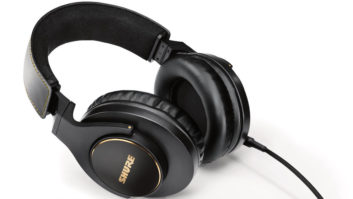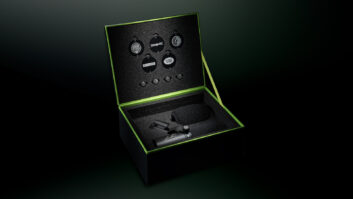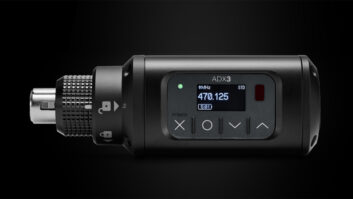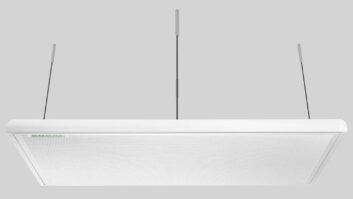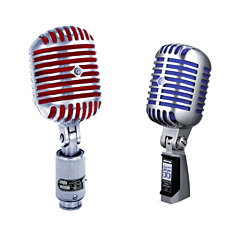
New and old: Shure’s original Unidyne 55 (left) and the new Super 55
The word “classic” is probably one of the most misused terms in pro audio, and these days, especially in terms of digital technology, it seems that just about anything that stays around for more than about a year or so is suddenly raised to that exalted status. But if you want an example of a real classic—the genuine article—Shure’s Unidyne 55 surely meets the test, by anyone’s standards.
But First, a Few Facts
After more than 70 years in production, Shure’s 55 Series is surely the longest running product in audio history. The story begins in 1937 with Shure engineer Benjamin Baumzweiger (he later changed his last name to Bauer) looking for a single-capsule approach to creating a unidirectional microphone. Prior to this, most unidirectional patterns were achieved by multi-element mics that combined the outputs of omni and figure-8 capsules via a switch or panpot. The concept worked, but the result was bulky mics with uneven frequency response and unpredictable directional patterns.
Baumzweiger experimented with capsules having front and rear openings that allowed sound waves to reach the diaphragm. Partially blocking the rear openings created a short phase delay that effectively cancelled the sounds from the rear. Varying the rear port resistance created various directional patterns—cardioid, hypercardioid and supercardioid—and the Unidyne was born. Shure announced its first model Unidyne 55 A/B/C (three versions with different output impedances) in 1939.
The model 55 was an immediate hit, and with its clear sound, high feedback resistance and rugged dynamic capsule ideally suited for the growing needs of live sound and remote broadcast engineers, the 55 soon became accepted as a standard for decades to come, while its stylish art deco looks became a widely recognized, iconic symbol for a microphone.

The Model 55 was immortalized on this Elvis commemorative U.S. postage stamp in 1994.
Numerous improvements followed, and with its popularity in the early days of rock, the 55 eventually took on the nickname “the Elvis mic,” even being immortalized on a portrait of The King on a U.S. postage stamp in 1994. With retro looks fully in vogue, Shure rechristened the mic as the 55SH Series II in 1996, bearing the model 55S body introduced in 1951, but with upgrades like a standard XLR connector and a modern SM48-style element. And like the 1939 version, the 55SH Series II was also a hit, with the showing up on stages, music videos, movies, TV shows—just about everywhere.
Checking out the New Kid
The latest generation of the series is the Super 55, which keeps the cool chrome-plated, die-cast zinc body, but updates the mic with a new capsule. I’ve had a couple 55SH Series II mics in my inventory for years, and their great looks and solid construction made them a natural choice on gigs where a vintage look was required. So I was curious about this new version and wanted to check it out first-hand.
Beyond the striking vintage-look blue windscreen peeking out from behind the chrome grille, you’ll notice the difference between the 55SH II and the Super 55 right away. With the Super 55’s capsule based on Shure’s successful Beta 58A, there’s a substantial upward leap in performance. The frequency response extends out to 17 kHz, providing some extra air and articulation. At the other end, the Super 55’s bass response is smoother and seems more controlled, while the mic retains the 6 to 7k Hz presence boost that lets vocals cut through the mix.
The Super 55’s new supercardioid capsule works best with stage monitor placement slightly off to the side, with lobing at the 120-degree off-axis position rather than the straight-on cardioid approach. Also, the Super 55’s -53dBV/Pa sensitivity results in an output that’s approximately 5 dB hotter than that of the 55SH II, for increased gain-before-feedback.

Goodbye Feedback! On its release, the cardioid directional performance of the Unidyne 55 made it an immediate hit with performers.
Another nice change is the omission of the on/off switch, which could inadvertently get switched off, leaving vocalists starting a show with no audio. The Super 55’s “no switch/no problem” approach definitely makes life easier for the audio engineer.
The Super 55 is a definite update and easily the best-sounding 55 Series mic ever. So if you happen to have one (or a couple) 55SH II mics that you want to bring up to the latest spec, you’ll appreciate that Shure offers an R1155S replacement cartridge/55SH upgrade kit, allowing DIY-inclined owners to swap capsules for optimum performance. Nice!
The Super 55 retails at $311 ($249/street) and the original $199 SH55 II remains in production. And Shure recently announced a Special Edition Super 55 ($299 retail) version with striking black body and red windscreen—offered exclusively through Guitar Center.
Sometimes a classic just keeps getting better.
Find out more about the Shure Super 55 Special Edition Vocal Microphone.
Download or view a vintage Shure Model 55 spec sheet in PDF format.
For a complete list of Guitar Center store locations, go to gc.guitarcenter.com/locations.
Mix executive editor George Petersen also runs a small record label at www.jenpet.com.
